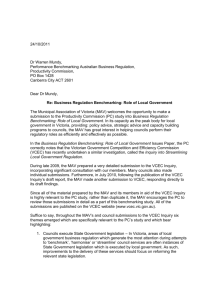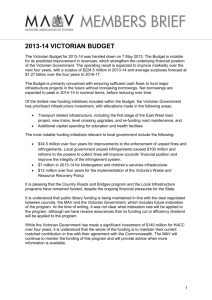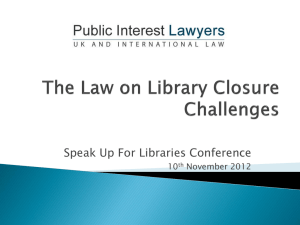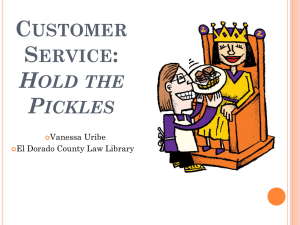2014-15 state budget submission - Municipal Association of Victoria
advertisement
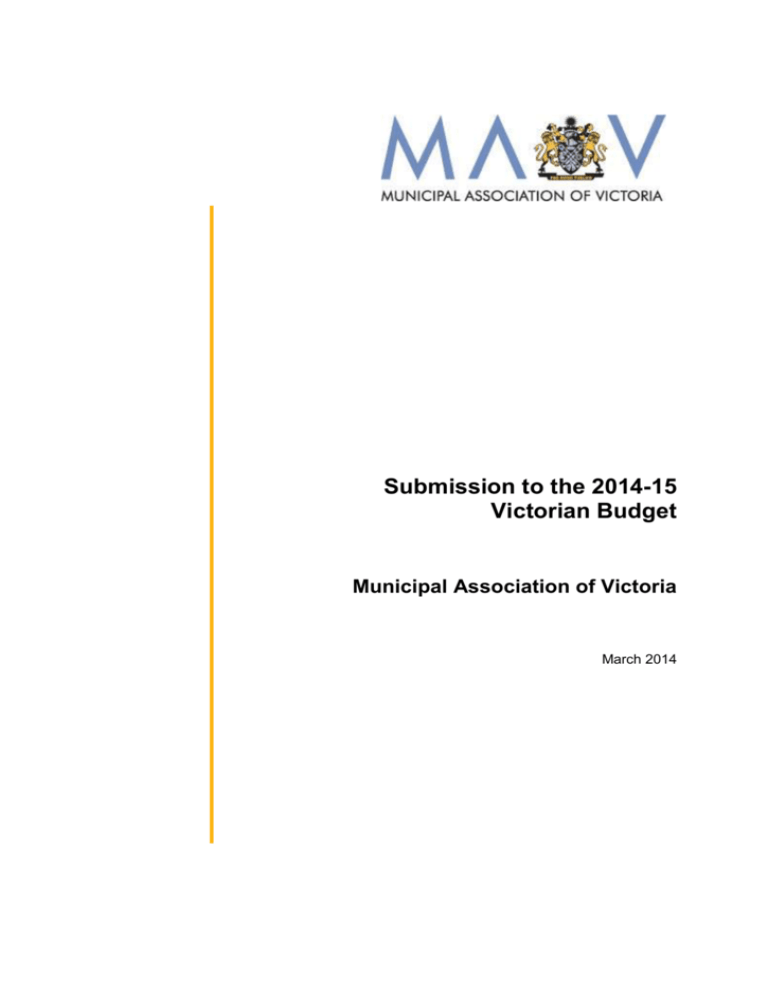
Submission to the 2014-15 Victorian Budget Municipal Association of Victoria March 2014 6 This submission has been prepared by the Municipal Association of Victoria (MAV. The MAV is the statutory peak body for local government in Victoria, representing all 79 municipal councils within the state. While this submission aims to broadly reflect the views of local government in Victoria, it does not purport to reflect the views of every individual council. © Copyright Municipal Association of Victoria, 2014. The Municipal Association of Victoria is the owner of the copyright in this publication. No part of this publication may be reproduced, stored or transmitted in any form or by any means without the prior permission in writing from the Municipal Association of Victoria. Table of Contents 1 Introduction ............................................................................................................... 3 2 Infrastructure programs ............................................................................................. 3 2.1 Local government rural and regional infrastructure programs ................................ 3 2.2 State infrastructure to growth areas ....................................................................... 4 2.3 Powerline relocation scheme ................................................................................. 6 3 Public library funding................................................................................................. 6 4 Flood mitigation infrastructure ................................................................................... 9 5 Roadside pests ......................................................................................................... 9 6 Planning.................................................................................................................. 10 6.1 Metropolitan Strategy and Regional Growth Plans ............................................... 10 6.2 Planning reform ................................................................................................... 10 6.3 Support for rural councils ..................................................................................... 11 7 2 References ............................................................................................................. 12 1 Introduction The Municipal Association of Victoria (MAV) welcomes the opportunity to provide a submission to the Victorian Government’s 2014-15 Budget. In recognition of the challenging budget conditions, the MAV has focused requests in the submission on funding programs that will provide long-term benefits to the Victoria, primarily through the continuation of existing or recently expired infrastructure programs. Victorian councils have a long history of providing infrastructure which provides economic and social value to their communities – from roads and bridges to community facilities. The MAV would welcome the opportunity to meet with representatives from the Victorian Government to discuss these matters further. 2 Infrastructure programs 2.1 2.1.1 Local government rural and regional infrastructure programs Background The Victorian Government has, since its election, provided significant funding for local infrastructure in rural and regional municipalities. The Regional Growth Fund, which includes the Putting Locals First program and the Local Government Infrastructure program, provides funds of $200 million over its first four years for councils and local communities (additional funding is provided for strategic projects). In addition, the Country Roads and Bridges program provides 40 rural and regional councils with up to $4 million each over four years. The MAV commends the Victorian Government for its significant investment in local infrastructure projects and seeks a commitment from Government beyond its current term. 2.1.2 Local government infrastructure and financial strength The financial strength of local government is heavily influenced by the state of its infrastructure. This is especially the case for rural and regional councils, where the failure to adequately maintain and renew infrastructure creates a long-term funding pressure. Assets that have not been maintained or renewed will have to be brought back to a useable standard, effectively creating a liability. Significant analysis — for example, from the Auditor-General and the MAV — has indicated that infrastructure backlogs remain the most substantial financial challenge for local government. The importance of infrastructure renewal is identified in the Auditor-General’s analysis of councils’ financial strength through its annual local government audit program. The report utilises two indicators that directly measure councils’ performance in managing their infrastructure and capital assets — the capital replacement ratio and the average renewal gap ratio. The former measures the extent to which capital funding meets or exceeds the degradation of existing capital stock through depreciation. The later measures the extent of any renewal gap. At the aggregate level, there is generally good performance on these measures. The performance at the individual council level, however, shows considerably greater 3 diversity, with many rural and regional councils facing difficulties in this area. The recent defined benefit superannuation shortfall has placed significant pressure on the sector’s capacity to finance infrastructure, particularly rural and regional municipalities with limited rate bases. The MAV has undertaken a financial strength analysis of councils since 1997-98, which identifies financial difficulties on the basis of long-term liabilities (both debt and infrastructure backlogs), cost structures and revenue effort. The analysis has indicated significant improvement at the aggregate level, although there are a number of councils that continue to face significant financial pressures. 2.1.3 Social and economic value of infrastructure While there is little doubt that infrastructure shortfalls are a financial challenge for councils, it ultimately has an affect on the community through sub-optimal infrastructure. This influences the local and regional economic efficiency through the quality of road networks (particularly for agricultural regions) as well as access to high quality social infrastructure (such as community halls, sporting facilities, etc). Research has supported the value of sporting activities in rural communities as a means of increasing health and social capital outcomes (see, for example, Townsend, et al, 2002). The Government’s investment in this type of infrastructure has also boosted the capacity of councils to ensure that sporting and community activities occur in good quality facilities. The Victorian Government’s investment in local infrastructure for rural and regional communities is of significant benefit to the financial viability of councils and the social infrastructure available to communities. 2.1.4 Request The MAV requests that the Victorian Government: Extends the Country Roads and Bridges program for a further four years beyond 2014-15 Commits to the second tranche of funding for the Regional Growth Fund and renews the Putting Locals First and Local Government Infrastructure programs. 2.2 State infrastructure to growth areas Victoria’s population grew by over 475 000 between 2007 and 2012, of which 43 per cent was concentrated in six growth councils in Melbourne’s perimeter. These six councils – Wyndham, Hume, Melton, Whittlesea, Casey and Cardinia – are among the quickest growing areas of Australia and are accommodating historically significant population growth. The consequences of this rapid population growth are clear: significant new investment is required in a range of state and local infrastructure projects to ensure the community has access to adequate health, education, community and transport services. 4 Significant work has been undertaken by the growth councils, along with the Victoria Government to plan for future population growth. Nonetheless, significant infrastructure gaps exist in these areas, with research commissioned by the Interface Council Group estimating that over the next 15-years, almost $10 billion in investment will be required to cater for increased population growth (Essential Economics, 2013). These estimates include the construction of kindergartens, TAFEs, primary and secondary schools, hospitals, aged care facilities and public transport. Good quality, well located and timely community infrastructure results in lower costs of living for residents in emerging communities and reduces the longer term negative social and economic impacts associated with delayed or under provision of assets. Instruments aimed at capturing some of the value from development of greenfield sites (such as the growth area charge) have merit as funding sources but are unlikely to provide sufficient revenue to achieve the required project financing. Furthermore, raising revenue through these sources can also conflict with alternative policy goals, such as improving housing affordability. One of the most fundamental tasks facing interface and growth areas is a need to overcome decades of underinvestment in public transport (particularly heavy rail) infrastructure to provide comparable service levels to existing metropolitan areas. The cost of public transport infrastructure is likely to be significant and will require funding from both state and federal governments. There is a strong link between community wellbeing and transport infrastructure, due to the access it provides to employment, recreation and community services. Sustained under-investment in public transport infrastructure for many decades has created inequality of access to community services across metropolitan Melbourne. The Australian Bureau of Statistics Melbourne Social Atlas 2006 demonstrated that jobs and services tend to cluster along the main rail lines. It is well known that residents of poorly serviced suburbs have higher levels of car ownership and more vehicle kilometres travelled. The Department of Transport, Planning and Local Infrastructure’s VISTA data reveals that residents of middle and outer ring suburbs overwhelmingly rely on private vehicles to travel. There is a critical deficiency in transport infrastructure, other than roads, in many growing suburbs, which restricts their capacity to attract and accommodate increased population growth, employers and service providers. While Plan Melbourne seeks to concentrate more population growth in existing areas, there is little doubt that the growth areas will continue to accommodate a significant portion of Melbourne’s future growth. Plan Melbourne estimates a 1.5 million increase in the city’s population by 2050. Effective implementation of Plan Melbourne will require supporting and enabling infrastructure to underpin new greenfield developments with particular focus on new public transport infrastructure. It is essential that the Victorian Government provides clear signals to the market, communities and councils by commencing the funding of the infrastructure requirements which will enable the implementation of the Plan Melbourne framework. As an immediate step, the MAV strongly advocates for the funding of the Melbourne Metro project, to increase the capacity of the 5 Request Funding within the 2014-15 Victorian Budget to support the Plan Melbourne implementation, particularly as it relates to infrastructure to support the projected population growth in Melbourne’s growth areas. 2.3 Powerline relocation scheme The Powerline Relocation Scheme was a highly successful Victorian Government program that provided funding to local communities to improve the visual amenity of powerlines in areas with high pedestrian or vehicle activity, and areas of environmental, historical or scenic importance. The scheme provided funding for more than 250 projects across Victoria to implement engineering solutions, such as undergrounding and aerial bundled cabling of powerlines, to increase the accessibility and utilisation of open spaces and increase the aesthetic appeal of streetscapes. The project also provided a number of safety benefits, including for elderly and disabled Victorians. Funding for the program was based on co-contributions from a mix of sources including councils, residents, businesses and other grant sources. The Powerline Relocation Scheme was discontinued at the same time that new regulations governing vegetation around powerlines were introduced, requiring increased distances be maintained between trees and powerlines. The resulting amenity, social and environmental impacts, particularly in urban low bushfire risk areas, have been significant. The MAV has advocated for the development of a riskbased approach to managing trees around powerlines that balances safety, amenity and environmental considerations. We also believe that access to affordable engineering solutions, including undergrounding, insulating and bundling of wires, is critical to ensure that the amenity of our communities is protected. The benefits of street trees are significant and include reduced heat island effect, increased property value, reduced stormwater runoff, improved habitat and biodiversity, and reinforced sense of place and city identity. Reinstatement of the Powerline Relocation Scheme is a practical and effective means by which the State can enhance and preserve Victoria’s streetscapes. Request $5 million per annum over four years for a reinstated Powerline Relocation Scheme. 3 Public library funding Public libraries are a key institution in Victorian communities. Public libraries in Victoria are one of the success stories emanating from a very robust partnership between local and state governments. Their benefits are many — they promote literacy and education, provide access to IT facilities, and support community building. Despite their importance to communities, core recurrent funding from the Victorian Government has failed to keep pace with the cost of delivering the service. 6 The MAV has worked cooperatively with the Victorian Government throughout the Tomorrow’s Library project and has had long-term representation on the Ministerial Council on Public Libraries (MAC). While the Tomorrow’s Library recommendations foreshadow a number of projects that will enhance the services delivered by public libraries and introduce several beneficial reforms, the MAV believes that the critical issue facing public libraries is ongoing sustainability of the service. An indexation factor that reflects the core movement in costs for the service recurrent funding provided by the Victorian Government is recommended. In addition, the MAV seeks a significant and sustained increase in recurrent funding. Underpinning the importance of public libraries services is a cost benefit assessment undertaken by SGS Economics and Planning which found that for every dollar invested in the sector, benefits of $3.56 were produced (State Library of Victoria and Public Libraries Victoria Network, 2011). The benefits produced by libraries cover several domains, including education, access to core IT services and community building. The economic impact assessment of Victorian public libraries estimated that the level of economic activity supported each year is; $722m in Victorian income, $120m in Victorian added value (or gross state product), 4430 full time equivalent jobs. The contribution of public libraries to education and literacy is well understood — the MAV’s previous Budget Submissions has highlighted PISA data that shows a clear association between accessing public libraries and reading and literacy scores. This has also been supported by the Libraries Building Communities (2005) report, which recognised the important role public libraries play in supporting school and tertiary education students. Public library services provide essential IT access. Data collected by the Public Libraries Victoria Network (PLVN) shows that public libraries provided in excess of 3.3 million computer bookings in the 2012-13 year, with a further 1.7 million wireless sessions. Libraries are also providing significant training to the community through digital literacy and other sessions (for example, they provided training to over 20 000 people in 2012-13 on digital literacy). Libraries have taken on providing devices for the public to use in the library to access the internet however the capital cost of this relies heavily on local government. Several libraries are looking at loaning out devices, a trend already evident in Californian and Canadian libraries. Coupled with the accessibility of services to the whole community, libraries play an important role in providing access to broadband and technology for disadvantaged communities. These functions in public libraries are particularly important given the increasingly difficult economic climate. Increasing unemployment across Australia, along with scheduled closing of major manufacturers, suggests that the state is likely to experience challenging economic conditions. Public libraries provide facilities for jobseekers to identify job vacancies through online sources, complete and submit job applications. For those sections of the workforce that do not otherwise have access to hardware/broadband or have the knowledge to participate in these ways, public libraries are an important gateway to labour force participation. 7 Libraries play an important role in building local communities. Major reviews of public libraries have noted that libraries inherently have a community-building aspect to their role. This includes offering safe spaces for interactions between community members and offering meeting spaces. Various reports have noted the value of this role: the current Tomorrow’s Library review identifies libraries’ community building as one of the service’s key attributes and both the Dollars, Sense and Public Libraries and the Libraries Building Communities reports identified this as a strength of the service. Most libraries will include community building as one of their goals. For example, the Geelong Regional Library Corporation identifies stronger inclusive communities as one of its three goals: We aim to provide a place and a space that is welcoming, engaging and accessible by all in our community who want to read, learn and access information. We embrace and celebrate all cultures. We acknowledge and appreciate diversity in heritage, ideas and abilities, and by facilitating connectedness contribute to personal, community and regional growth. We exist in and for our community, welcoming in and reaching out to all who wish to use the library (Geelong Regional Library Corporation, 2013). This desire to enhance their local communities is reflected in the operation of these facilities during emergencies. Anecdotal evidence suggests that library services are quick to respond to emergency events – many extended their opening hours to provide a cool refuge during heatwaves while others act in a more formal capacity. For example, libraries in Mitchell have acted as recovery centres, with extended staffing and opening hours. A funding partnership and a new financial agreement are sought for public libraries for the next four years and beyond. Additional funding will allow councils to continue to: update IT facilities, progressively introduce system changes identified by the Tomorrow’s Library project, and update their collections. Living libraries The Victorian Government has been providing funding for capital projects in libraries through the Living Libraries program. This critical program has most recently provided $17 million over four years. A new small library now costs in the order of $4$5m. Bendigo have just opened a refurbished library for $9.5m, Melton a new library$20m and Geelong has commenced construction of their new library at a cost of $45m. The balance of state contribution to total project costs has been eroded. Libraries are being built more environmentally efficiently with higher standards now than four years ago. The maximum grant ceiling of $750,000 now does not represent the value it once did. The MAV seeks the support of the Government to renew this program to continue to support the construction of new libraries and the refurbishment of existing library facilities. Premier’s Reading Challenge program The State Government currently partners with local government to provide reading incentives for our young and teen population through the Premier’s Reading 8 Challenge program. Under this program, $1 million per annum is provided to purchase stock to complement the reading lists for the program. The MAV asks that a new four year allocation of the program be funded. Request The MAV requests: Commitment to the current program funding with an appropriate indexation factor for current service delivery Progressive increase in the recurrent funding over four years to increase the total annual contribution by $10 million per annum $20 million over four years for the extension of the Living Libraries program, including indexation future program indexation Continued funding of $1m per annum for public libraries to support the Premier’s Reading Challenge 4 Flood mitigation infrastructure The Government’s response to the Environment and Natural Resources Committee report into Flood Mitigation Infrastructure and Response supported making councils responsible management and maintenance of urban levees. Where there is a demonstrated benefit and community support, the Government has indicated it will contribute to new urban levees or major upgrades to existing urban levees. Maintenance costs are to be borne by local government, applying a beneficiary pays principle and collected through rates or special charges. Councils will also be responsible for rural levees where there is demonstrated community support, including a willingness to pay. The Government has not indicated an intention to contribute to major upgrades of rural levees. The MAV is concerned that the new policy will have a large financial impact on a small number of councils. Work is currently underway to assess the degree of impact and to identify those councils (and communities) that may not have a capacity to pay for essential levee investment and maintenance. The MAV requests further investment in local flood studies to identify priority levees. 5 Roadside pests The issue of roadside weeds and pests and the responsibilities of parties under the Catchment and Land Protection Act 1994, and other legislation, has been unclear and contentious for many years. In response to ambiguities about the responsibility for managing roadside pests, the Bailey Report analysed the costs and benefits of managing regionally prohibited weeds and pests. The key recommendation of the report was that regionally controlled weeds on local roads were most efficiently managed by councils, but that there was a shared responsibility and that the state should contribute funds. The Government has accepted the findings of the report and determined introduced amendments to the Catchment and Land Protection Act to implement these recommendations. They also provided $7.8 million through to 30 June 2015 to 9 councils, distributed on a road length basis, unrelated to weed density, types of weeds, or the level of community activity. The amendment (Catchment and Land Protection Amendment Bill 2013) was largely in line with the outcomes of the Minister's Working Party Report. It uses the Roadside Weed and Pest Animal Management Plan (called a Control Plan in the Working Party Report) as the vehicle to define what is to be managed and subsequently their responsibility. Councils responsible for managing weeds and pests on 'municipal roads' VicRoads responsible for managing weeds and pests on state-owned roads – even where councils may be the road manager under the Road Management Act. Councils must take steps, as far as possible, to eradicate regionally prohibited weeds. Councils must take 'reasonable measures' to control regionally controlled weeds. ‘Reasonable’ not defined in the legislation. The amended CALP Act is intended to come into effect on 1 July 2014 Local government requires greater funding certainty for this responsibility and the MAV calls on the Victorian Government to make a long-term funding commitment beyond the current tranche of funding which expires at the end of 2014-15. The MAV calls for funding to be based on the size of the weed and pest control effort, based on the effort identified through each council’s Roadside Weed and Pest Animal Management Plan. Potential annual funding levels for individual councils should be as follows: Small workload identified by Plan $43k Medium workload, $65k Large workload $91k Depending on the actual applications from councils, the funding envelope required would be around $4 million per annum. 6 Planning 6.1 Metropolitan Strategy and Regional Growth Plans The Victorian Government prepared Plan Melbourne and eight Regional Growth plans to manage growth and change across Victoria. The sector has invested a significant amount of goodwill in these plans and is a key partner in their delivery. We call for the state to develop a whole of government infrastructure and services plan and finance model to meet prioritised need. This approach illustrates government’s intentions and enables both local government and the private sector to align their work programs and funding opportunities. 6.2 Planning reform The planning system has undergone a significant amount of policy and process reform, notably the Metropolitan Strategy, Regional Growth Plans, Reformed Zones, 10 State Planning Policy Framework and VicSmart. To successful implement these reforms, consequential changes will be required at a municipal level. We call for support for councils and DTPLI to ensure schemes and process are amended to give effect to these reforms. 6.3 Support for rural councils The MAV calls for ongoing support for rural and regional councils through the Rural Council Planning Flying Squad and the funding of a position within the MAV to undertake rural and regional planning projects. The Rural Council Planning Flying Squad has provided much needed advice for rural and regional councils on planning matters. Assisting with upwards of 120 projects, they have reduced planning permit backlogs and enabled councils to progress high order strategic projects and get on the front foot. We call for this program to be refunded to assist councils with updating schemes to align with recent planning policy initiatives. The currently funded rural and regional planning policy position within the MAV has generated significant sector benefit through the project management of rural and regional planning programs, the delivery of quarterly forums and an annual conference. Over a three year period, the role has enable councils to collaborate of issues of common concern, provide feedback as a sector on the regional growth planning process and research topical planning issues, such as how to manage small lots through the planning schemes, the financial costs of settlement patterns and the resource implications of overlay controls. 11 7 References Townsend M, Moore J, Mahoney M. (2002) Playing their part: the role of physical activity and sport in sustaining the health and well being of small rural communities. Rural and Remote Health 2: 109. (Online). Essential Economics (2013) One Melbourne or Two? Implications of population growth on infrastructure and services in interface areas, report prepared by Essential Economics for Interface Councils, http://apo.org.au/sites/default/files/docs/EssentialEconomics_One_Melbourne_or_Two_20 13.pdf, accessed 29 January. Library Board of Victoria (2005) Libraries Building Communities, published by State Library of Victoria. Geelong Regional Library Corporation (2013) Annual Report 2012-13 12
